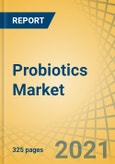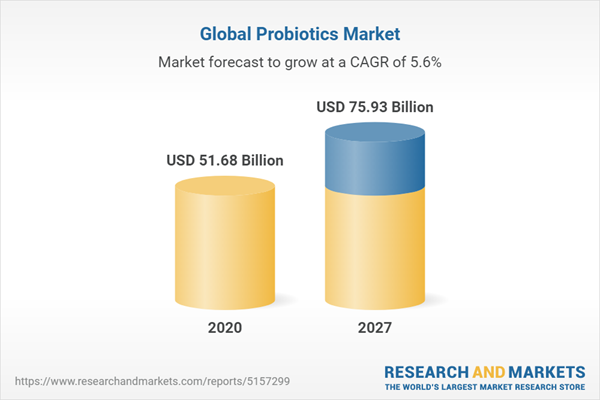The global probiotics market is expected to grow at a CAGR of 5.6% from 2020 to 2027 to reach $75.9 billion by 2027. This research report provides an in-depth analysis of the market in five major geographies and emphasizes the current market trends, market size, market share, recent developments, and forecast till 2027.
The growth of this market is mainly attributed to the growing consumer awareness regarding the health benefits of probiotics, increasing use of probiotics as an alternative to antibiotics, and growing research programs on probiotics for new applications. Moreover, the growing use of probiotics for children and e-commerce growth is expected to create lucrative opportunities for players operating in this market. However, complex regulations related to probiotics are expected to hinder the growth of this market to some extent.
The study offers a comprehensive analysis of the probiotics market with respect to strain, product type, form, sales channel, end user, and geography. The probiotics market is mainly segmented by strain (bacteria and yeast strain products), product type (functional food & beverages, medical & dietary supplements, and animal feed), form (liquid and dry), sales channel (offline and online sales), end user (humans and animals), and geography. The study also evaluates industry competitors and analyses the market at a country level.
Based on strain, the yeast strain products segment is expected to grow at the highest CAGR during the forecast period. The increasing use of yeast strain in animal feed & functional food and the rising use of probiotics as an alternative to antibiotics are the major drivers for the growth of this segment. Besides, increasing demand for yeast strain-based medicines due to proven positive results for reducing the risk of chronic diseases is expected to boost its demand in the forecast period.
Based on product type, the functional food & beverages segment is expected to command the largest share of the overall probiotics market in 2020. The large share of this market is mainly attributed to the rising health and wellness trends; growing consumer interest for functional food, particularly probiotics that can support digestive health; and the growing application of probiotics in yogurt.
Based on form, the dry form segment is expected to grow at the highest CAGR during the forecast period. Dry probiotics offer advantages, such as better handling & transport, ease of use, affordability, and the ability to avoid costly formulation mistakes.
Based on sales channel, the probiotics market is segmented into offline and online sales. The offline sales segment is expected to command the largest share of the overall probiotics market in 2020. The large share of this segment is mainly attributed to the rising interest in healthy eating habits, growing number of pharmacies, and the expanding probiotics supplements industry.
Based on end user, the animals segment is expected to grow at the highest CAGR during the forecast period. The animal probiotics sector has witnessed significant growth due to the growing pressure regarding reducing the use of antibiotics in feed. Further, the growing awareness among pet owners, cattle farmers, and hobbyists regarding the advantages of probiotics for animal health offer significant opportunities for players operating in the animal probiotics market.
Geographically, Asia-Pacific is expected to command the major share of the overall probiotics market in 2020. The leading position of the region is primarily attributed to the increased consumer awareness regarding digestive health, immunity, and overall wellness; growing number of diabetics and overweight people; increasing demand for non-dairy probiotics food; the presence of key players in the digestive health products marketspace; and rising innovations in probiotics formulations.
The report includes a competitive landscape based on an extensive assessment of the key strategic developments adopted by the leading market participants in the probiotics market over the last four years (2017-2020). The key players operating in the probiotics market are Probi AB (Sweden), BioGaia AB (Sweden), Nestlé S.A. (Switzerland), Chr. Hasen Holding A/S (Denmark), Danone S.A. (France), Yakult Honsha Co., Ltd. (Japan), Lallemand Inc. (Canada), Lifeway Foods Inc. (U.S.), Dupont de Nemours, Inc. (U.S.), Kerry Group plc (Ireland), Archer Daniels Midland Co. (U.S.), Deerland Probiotics & Enzymes Inc. (U.S.), KeVita, Inc. (a part of PepsiCo Inc.) (U.S.), Evolve BioSystems (U.S.), Cell Biotech Co., Ltd. (Korea), and Probiotical S.p.A. (Italy).
The growth of this market is mainly attributed to the growing consumer awareness regarding the health benefits of probiotics, increasing use of probiotics as an alternative to antibiotics, and growing research programs on probiotics for new applications. Moreover, the growing use of probiotics for children and e-commerce growth is expected to create lucrative opportunities for players operating in this market. However, complex regulations related to probiotics are expected to hinder the growth of this market to some extent.
The study offers a comprehensive analysis of the probiotics market with respect to strain, product type, form, sales channel, end user, and geography. The probiotics market is mainly segmented by strain (bacteria and yeast strain products), product type (functional food & beverages, medical & dietary supplements, and animal feed), form (liquid and dry), sales channel (offline and online sales), end user (humans and animals), and geography. The study also evaluates industry competitors and analyses the market at a country level.
Based on strain, the yeast strain products segment is expected to grow at the highest CAGR during the forecast period. The increasing use of yeast strain in animal feed & functional food and the rising use of probiotics as an alternative to antibiotics are the major drivers for the growth of this segment. Besides, increasing demand for yeast strain-based medicines due to proven positive results for reducing the risk of chronic diseases is expected to boost its demand in the forecast period.
Based on product type, the functional food & beverages segment is expected to command the largest share of the overall probiotics market in 2020. The large share of this market is mainly attributed to the rising health and wellness trends; growing consumer interest for functional food, particularly probiotics that can support digestive health; and the growing application of probiotics in yogurt.
Based on form, the dry form segment is expected to grow at the highest CAGR during the forecast period. Dry probiotics offer advantages, such as better handling & transport, ease of use, affordability, and the ability to avoid costly formulation mistakes.
Based on sales channel, the probiotics market is segmented into offline and online sales. The offline sales segment is expected to command the largest share of the overall probiotics market in 2020. The large share of this segment is mainly attributed to the rising interest in healthy eating habits, growing number of pharmacies, and the expanding probiotics supplements industry.
Based on end user, the animals segment is expected to grow at the highest CAGR during the forecast period. The animal probiotics sector has witnessed significant growth due to the growing pressure regarding reducing the use of antibiotics in feed. Further, the growing awareness among pet owners, cattle farmers, and hobbyists regarding the advantages of probiotics for animal health offer significant opportunities for players operating in the animal probiotics market.
Geographically, Asia-Pacific is expected to command the major share of the overall probiotics market in 2020. The leading position of the region is primarily attributed to the increased consumer awareness regarding digestive health, immunity, and overall wellness; growing number of diabetics and overweight people; increasing demand for non-dairy probiotics food; the presence of key players in the digestive health products marketspace; and rising innovations in probiotics formulations.
The report includes a competitive landscape based on an extensive assessment of the key strategic developments adopted by the leading market participants in the probiotics market over the last four years (2017-2020). The key players operating in the probiotics market are Probi AB (Sweden), BioGaia AB (Sweden), Nestlé S.A. (Switzerland), Chr. Hasen Holding A/S (Denmark), Danone S.A. (France), Yakult Honsha Co., Ltd. (Japan), Lallemand Inc. (Canada), Lifeway Foods Inc. (U.S.), Dupont de Nemours, Inc. (U.S.), Kerry Group plc (Ireland), Archer Daniels Midland Co. (U.S.), Deerland Probiotics & Enzymes Inc. (U.S.), KeVita, Inc. (a part of PepsiCo Inc.) (U.S.), Evolve BioSystems (U.S.), Cell Biotech Co., Ltd. (Korea), and Probiotical S.p.A. (Italy).
Key questions answered in the report:
- Which are the high growth market segments in terms of the strain, product type, form, sales channel, end user, and countries/regions?
- What is the historical market for probiotics across the globe?
- What are the market forecasts and estimates for the period of 2020-2027?
- What are the major drivers, restraints, and opportunities in the probiotics market?
- Who are the major players in the global market, and what share of the market do they hold?
- Who are the major players in various countries, and what share of the market do they hold?
- How is the competitive landscape?
- What recent developments have taken place in the probiotics market?
- What are the different strategies adopted by the major players in this market?
- What are the key geographic trends, and which are the high-growth countries?
- Who are the local emerging players in the probiotics market, and how do they compete with the other market players?
Table of Contents
1. Introduction
2. Research Methodology
4. Market Dynamics
6. Global Probiotics Market, by Strain
7. Global Probiotics Market, by Product Type
8. Global Probiotics Market, by Form
9. Global Probiotics Market, by Sales Channel
10. Global Probiotics Market, by End User
11. Probiotics Market, by Geography
12. Competitive Landscape
13. Company Profiles (Business Overview, Financial Overview, Product Portfolio, Strategic Developments)
14. Appendix
Companies Mentioned
- Probi AB (Sweden)
- BioGaia AB (Sweden)
- Nestlé S.A. (Switzerland)
- Chr. Hasen Holding A/S (Denmark)
- Danone S.A. (France)
- Yakult Honsha Co. Ltd. (Japan)
- Lallemand Inc. (Canada)
- Lifeway Foods Inc. (U.S.)
- Dupont de Nemours Inc. (U.S.)
- Kerry Group plc (Ireland)
- Archer Daniels Midland Co. (U.S.)
- Deerland Probiotics & Enzymes Inc. (U.S.)
- KeVita Inc. (a part of PepsiCo Inc.) (U.S.)
- Evolve BioSystems (U.S.)
- Cell Biotech Co. Ltd. (Korea)
- Probiotical S.p.A. (Italy).
Table Information
| Report Attribute | Details |
|---|---|
| No. of Pages | 325 |
| Published | March 2021 |
| Forecast Period | 2020 - 2027 |
| Estimated Market Value ( USD | $ 51.68 Billion |
| Forecasted Market Value ( USD | $ 75.93 Billion |
| Compound Annual Growth Rate | 5.6% |
| Regions Covered | Global |
| No. of Companies Mentioned | 16 |









